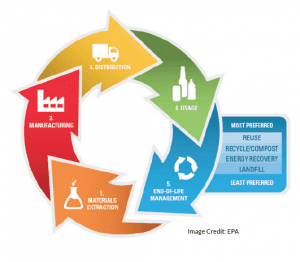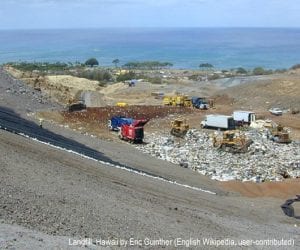Most of us are aware of the basics when it comes to watching our eco-footprints. It doesn’t take much to turn off the lights when leaving a room, rinse out an aluminum can and recycle it after drinking a soda, or bring a reusable tote bag to the grocery store.

However, while the “three R’s” are important steps, they don’t tell the full story of our society’s addiction to stuff. A life cycle analysis, or LCA, is a technique that assesses the impact of a product, from the materials used to make it to its ultimate disposal. An LCA can be a great tool to identify changes that can decrease a product’s negative effects on the Earth over the course of its life.
All of the items we buy—disposable or reusable, expensive or cheap, beloved or ignored—have a life long before they make it into our possession. Consider the extraction of the materials needed to make the filaments in that light bulb you’re turning off, or the carbon emissions of shipping that can of soda, on a palette with dozens of others, to your local grocery store. Think about the machines or people that sewed your stylish and handy reusable tote. And in most cases, stuff has a life after we’re done with it, too- whether it’s the dull world of a landfill or being shipped to another continent for resale.
The 5 Steps in a Life Cycle Analysis
- Materials
Matter can’t be created or destroyed, so the materials that form your item had to come from somewhere. Maybe they were grown in the ground, like cotton, which is the most commonly used fabric in the world for clothes. While it may not be as fossil fuel-intensive as plastic-based synthetic fibers, growing cotton uses about 2 percent of the world’s arable land and 3 percent of its available fresh water. Or, maybe these materials were mined. For example, the mineral coltan, found in most cell phones, is extracted largely from mines that disrupt the biodiverse ecosystems of the Democratic Republic of the Congo where critically endangered lowland gorillas live.
- Manufacturing
Once the raw materials are in place, they have to be actually made into your item. This may involve weaving, riveting, melting, dyeing, gluing, or all the above. This process usually requires energy and machinery, but there are other unexpected ways the manufacturing process can have an impact. For example, garment production often involves dyeing fabrics, which generates toxic pollution and can exhaust local water supplies.
- Distribution
Chances are, most of the things you buy weren’t grown, extracted, or manufactured near your house. They had to be brought to the store where you purchased them and then you had to get to that store. If you order online (not to call out any specific companies, but particularly if you get free 2-day shipping) they had to be rushed to your front door. Unlike passenger vehicles, delivery trucks are more likely to run on diesel fuel, which is a prime contributor to air pollution and the emissions that cause climate change.
- Usage
At last, you and your item finally meet! But the life cycle analysis doesn’t stop here. While you are using the product, its impact will continue. If it requires electricity, like most appliances, it’s continuing to use energy and thus most likely releasing greenhouse gas emissions. Or, if your item is reusable, it may require water, energy, and soap when cleaned. In the case of clothing made of synthetic fabrics, it can shed microplastics in the wash, which will end up in bodies of water and harm fish (and, potentially, people).
- Disposal
Once you say goodbye, you’re still on the hook for the rest of your item’s life. If you and your item part on bad terms and it ends up in a landfill, it will continue to take up space until it’s broken down naturally (which, in the case of plastics, is likely hundreds of years). But even recycling requires significant energy, money, and labor to make your thing into something new and fresh. And in some cases, we may think we’ve recycled something, only to have it end up in a landfill because its “batch” was too contaminated by non-recyclable items to salvage.
Using the Life Cycle Analysis in Your Own Life
Using these five steps, you can perform an LCA of any item in your home and consider how to be a responsible consumer during every step—not just when you use, reuse, and recycle your stuff. We currently have 7.6 billion reasons to care about how the things we buy and use can affect the environment we all share.
Download our lessons Secret Life of Stuff (middle school) and Secret Life of Tees (from our high school unit on Solid Waste) to explore this further in the classroom setting. And stay tuned for another LCA post, next time focusing on the social impacts that our stuff can have during each stage of its life.



